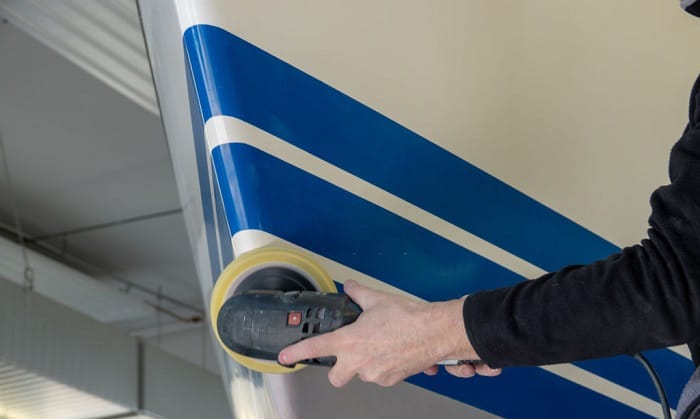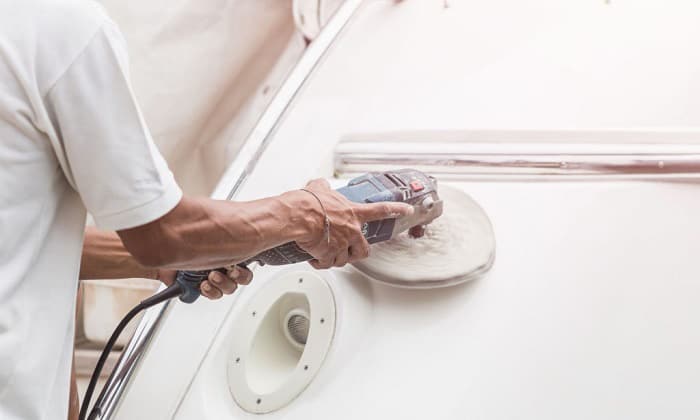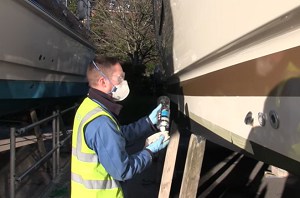Failure to carry on your boat’s maintenance has unpleasant consequences. The appearance is mainly affected when you neglect your responsibilities as a boat owner. To fulfill your role, you have to know how to polish a boat.
Your effort in polishing the boat hull will give you a glossy finish. This result can be obtained through a marine polishing product and electric buffer with a polishing head. You may also do the polishing manually with the help of a cloth. The application should be done in circular motions to evenly apply the polishing product.
If you have no idea where to start, this article will guide you every step of the way. So, you won’t regret sparing some minutes reading it.
Table of Contents
Different Surfaces on Your Boat That Need Polishing
Every inch of your boat, even the interior parts, needs polishing. As you know, your boat is composed of different materials. With this knowledge, you should be familiar with the specific polishing product required for each material.
1. Fiberglass
This is a lightweight material that floats. It’s dependable and easy to fix. You can buy kits that contain polishing products, cloth, and soap like TotalBoat Hand Polishing Kit and Poli Glow Kit.
You should choose a polishing product based on your boat’s condition. A safe bet is the 3m boat polish, which is available in light, medium, and heavy solutions.
2. Stainless steel
Stainless steel can still become rusty. Fix it with STAR BRITE Ultimate Aluminum Cleaner, Chemical Guys Heavy Metal Polish, Rolite Aluminum Polish, or 3M Aluminum Restorer and Polish.
3. Fabric
Fabric and textile are commonly seen on boat seats and sails. You’ll likely see leather on older boats and the high-end ones. Vinyl is common among the latest boat models and it can be polished by STAR BRITE Vinyl Cleaner, Meguiar Marine or RV Vinyl Cleaner and Protectant, or 303 Vinyl Protective Cleaner. When it comes to leather, get Adam’s Leather Care Kit and Better Boat Premium New Marine Leather Conditioner and Cleaner for polishing
4. Acrylic and glass
Acrylic is for screens and glass is for windows. You’ll need Plane Perfect Eyes Outside Plastic and Glass Windshield Cleaner, Rolite Scratch Ultra Fine Scratch Remover, or MEGUIAR’s Mirror Glaze Clear Plastic Cleaner to polish them.
Basic Steps in Polishing a Boat
Things that you’ll need:
- An electric buffer with variable speed
- Some double-sided buffing pads
- A microfiber cloth
- An extension cord
- A safety switch box
- Some protective gear
Basic steps to follow when polishing a boat:
The best way to polish a boat is through these basic steps:
Step 1: The boat is secured on the trailer
As common sense dictates, the boat should be out of the water during polishing. Ideally, complete this procedure when your boat is on the trailer. You’ll be moving around your boat so there should be enough space without piles of things next to it. To ensure that it’s hassle-free, the trailer should be on flat ground. You would also want to polish a boat hull in the open air to lessen the mess.
Step 2: Scrubbing
You’ll need a gallon of warm water and 240 ml of boat detergent for this step. A microfiber cloth or sponge can help you remove dirt and unwanted debris. Make sure to apply firm pressure to clean the entire boat.
Step 3: Rinsing and drying
Ensure that no speck of detergent remains on the surface as it can leave a residue that’s challenging to remove. A good way to dry is with a microfiber towel and circular motions.
Step 4: Acetone for wiping away grease
Dip a clean rag into the acetone and wring it to get rid of the excess liquid. Next, rub the rag on the greasy sections in circular motions. When one part of the rag becomes dirty, switch to the other side.
Cases may vary and some boat owners may need another piece of rag or more to finish the job. It’s best to wear protective gear like a facemask and a pair of safety glasses as acetone can cause nose and eye irritation.
Step 5: Getting rid of the stain
In this step, you need to get a reliable hull cleaner like STAR BRITE EZ-ON EZ-Off Boat Hull and Bottom Cleaner, and Boat Juice Exterior Cleaner. You may use a paintbrush to spread it over the hull or other parts of the boat that have stains. Give the cleaner 10 minutes before rinsing the area with water.
Step 6: Sanding (only if your boat is highly oxidized)
Your boat is at high risk of oxidation if you don’t use a boat cover during storage. If there is still heavy discoloration and a cloudy surface after you have done the previous steps, get 2,000-grit sandpaper and soak it in warm water. Then, take out any excess liquid.
The boat’s surface needs some lubrication so spray some water. Next, rub the sandpaper on the hull lightly in horizontal strokes. After wiping the oxidation, clean the surface again.
Step 7: Polishing the boat with the right product
The right polishing products for various materials are mentioned above so you won’t have to look high and low for the effective one. When you need to polish a boat gel coat, be extra careful. Gel coat is thin and some solutions with strong compounds can burn it.
You can begin to polish a boat with a buffer. The way to avoid creating streaks is practicing circular motions. It’s recommended to work in sections of two feet. Continue buffing until the surface turns glassy.
When using an electric buffer, it’s smart to start with a low speed to avoid splatter. Make sure that the polishing pads are attached to the buffer before you turn it on.
Step 8: Waxing
Rinsing is essential as there’s dust left by polishing. You ought to know that waxing your boat creates a layer of protection from UV rays and other harsh outdoor elements. Applying the wax can be done by hand or an electric buffer. Again, you have to do it in circular motions.
Two excellent boat waxes are Meguiar’s Flagship Premium Marine Wax and 3M Scotchgard Liquid Marine Wax. You have to read the product description or the label for special instructions. Apart from being picky with pads for polishing gel coat, you should be selective when choosing the dependable wax.
The wax should be dried before you move to the next step. You’ll know that it’s dry if it appears hazy. You can wrap up the polishing process with a buffer and soft towel or terry cloth. They will help you obtain a shiny surface.
Some Considerations in Polishing a Boat
- For fiberglass boats
Typically, fiberglass boats are covered with a gel coat that is susceptible to erosion and wear out when exposed to too much sunlight. Moreover, this special resin coating will end up looking dull and chalky. That’s why I mentioned earlier that you have to know the appropriate wax and polishing products for gel coats to provide protection.
- For aluminum boats
Low-micron cleaners are perfect for aluminum boats since they’re three in one. They can clean, brighten, and polish aluminum boats all at the same time. These products are also referred to as antioxidants as they prove to be effective even on old and worn-out aluminum boats.
When you own a painted aluminum boat, the polishing process is the same as the bare one. However, you may need patch-up kits if there are scratches. The covering is essential to create a consistent surface and appearance.
Summing it Up
Cleaning with water and detergent, sanding if necessary, polishing, and waxing are the steps you need to take. It simply shows that the procedure of how to polish a boat is easy. But you have to be particular with the products that you choose. They should be compatible with the material of your boat to obtain the desired result.

“My intention from the first day establishing Boating Basics Online is to provide as much help as possible for boaters who want to experience a first safe and convenient trip. So feel free to join us and share your beautiful journeys to the sea!”




